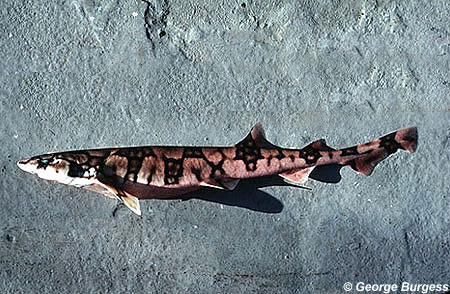
Scyliorhinus retifer
These slim sharks are reddish brown to light yellow underneath, with a distinctive dark brown or black chain pattern down their bodies. They have rounded snouts and large oval eyes, and somewhat lobed fins set further back towards their asymmetrical, notched caudal (tail) fin. Rarely growing longer than 18 inches, they eat primarily squid and small bony fishes. They are considered harmless to humans, and because of their coloring, they are popular in aquariums.
Order – Carcharhiniformes
Family – Scyliorhinidae
Genus – Scyliorhinus
Species – retifer
Common Names
- English: Chain dogfish, chain cat shark, or chain link shark
- Dutch: Kettingkathaai
- Finnish: Syvännepunahai
- French: Roussette maille
- Spanish: Alitán mallero
Importance to Humans
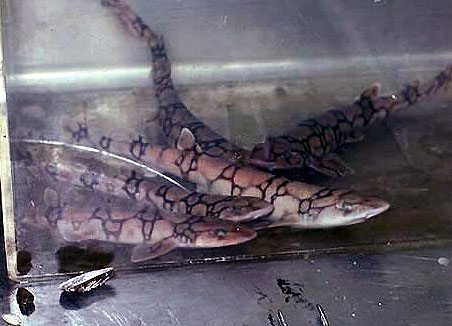
Large numbers of chain dogfish are taken as bycatch off the coast of Virginia near the Chesapeake Bay. This species is caught primarily by trawling in waters greater than 73.2 m (240 ft.) and at temperatures of 10°C (50°F). At this time, there is little interest in this species as a fishery. The chain dogfish is a popular aquarium display fish due to its small size (Castro, 2010).
Danger to Humans
Chain dogfish are considered harmless to humans due to their small size.
Conservation
The chain dogfish is currently listed as a species of “Least Concern” with the World Conservation Union (IUCN). The IUCN is a global union of states, governmental agencies, and non-governmental organizations in a partnership that assesses the conservation status of species.
> Check the status of the chain dogfish at the IUCN website.
Geographical Distribution
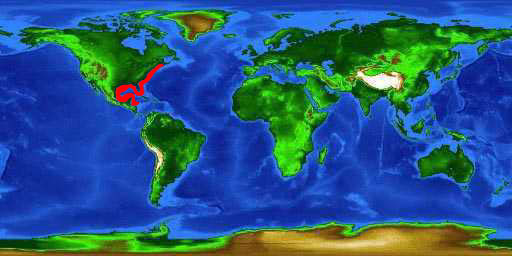
Occurring from Massachusetts (U.S.) to Florida and from the northern Gulf of Mexico south to Nicaragua in the western Atlantic Ocean. It is especially abundant in the general vicinity of the Chesapeake Bay, off the coast of Virginia. This species is absent from the Bahamas and the Antilles (Able and Flescher, 1991).
Habitat
As a demersal species (living close to the bottom), the chain dogfish resides in subtropical waters with temperatures from 8.5 -11.3 °C (47-52 °F). It is found along the outer continental shelf and upper slope. In the northern portion of its range, the chain dogfish lives at depths of 36-230 m (120-750 feet), while in its southern range it is found in waters deeper than 460 m (1,500 feet). The chain dogfish prefers structured habitats including rocky bottoms as well as living among man-made artifacts such as wires and cables (Able and Flescher, 1991).
Biology

Distinctive Features
Small with a slender body and wedge-shaped, blunt-tipped snout. The eye is narrow and somewhat oval in shape. The origin of the first dorsal fin is somewhat behind the free rear tips of the pelvic fins. The second dorsal fin is approximately half the size of the first dorsal. The pectoral fins are as broad as they are long with rounded corners. The outer margin is slightly convex and the distal margin is straight. The anal fin is subtriangular with nearly straight edges and a rounded apex. The small caudal fin has a square tip or indented at the midline. The caudal fin also has a defined notch (Compagno. 2005).

Coloration
Its bold coloration distinguishes it from all other sharks. The body is reddish-brown along the back and a yellowish shade on the underside. There is a chain-like pattern of black or dark brown lines on its back and sides. This coloration pattern helps this species blend into its bottom habitat. The eyes are yellowish-green (Compagno. 2005).
Dentition
Its narrow teeth are triangular with smooth edges. There is a large central cusp with secondary cusps located on either side of each tooth. These teeth are similar in both the upper and lower jaws. The upper jaw has 21-26 teeth on each side of the symphysis. The symphysial teeth number 0-2. The lower jaw teeth number 20-22 on either side of the 0-4 symphysial teeth (Compagno. 2005).
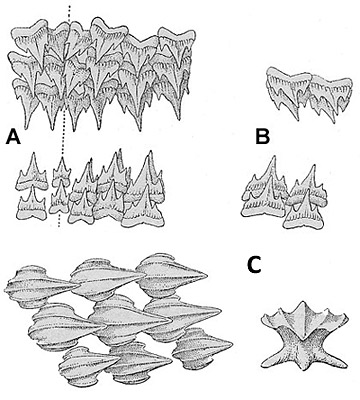
Denticles
The denticles are small, narrow, and flat. There are 3-5 ridges with the axial ridge most prominent. The anterior edge either is the posterior margin of the axial ridge or is notched between ridges. The surface of the skin feels smooth to the touch (Compagno. 2005).
Size, Age, and Growth
The largest male specimen caught measured 48 cm (18.9 in.) in length while the largest female measured 47 cm (18.5 in.) in length. At locations in the northern ranges of their distribution, maturation is thought to occur at smaller sizes than populations in the south. In the mid-Atlantic Bight, females mature at approximately 38 cm (15 in.) total length and males mature at 39.5 cm (15.6 in.). Age at maturation is approximately 8-9 years. Growth rates of juveniles decrease exponentially with increasing body weight as they mature and reach maximum size (Compagno. 2005).
Food Habits
Squid, small bony fishes, polychaete worms, and crustaceans. There is a dietary shift as sharks mature, with adults consuming more fish and invertebrates than juveniles (Compagno. 2005).
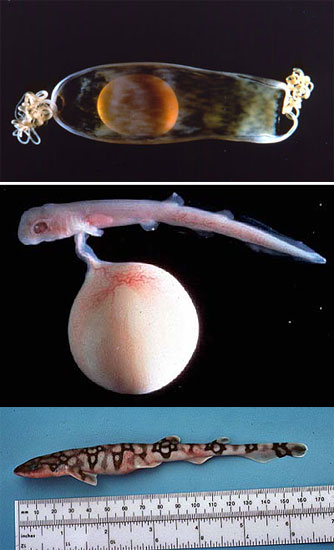
Reproduction
This species is oviparous or egg-laying. Each pregnant female releases two box-shaped egg cases after an unknown gestation period. Each egg case also referred to as a mermaid’s purse, measures about 6 cm long by 2 cm wide (2 in. x 0.9 in.) and has long stringy tendrils at each corner. The egg case is amber in color. Prior to release of the egg cases, the mother searches for bottom habitat with gorgonians and sponges or man-made structures for the tendrils to snag. These benthic invertebrates or structures provide an area to secure the egg cases (Sminkey and Tabit, 1992).
Adult chain dogfish often congregate in the nursery areas where females release egg cases. After the egg cases are released, there is no further parental involvement. The embryos are released from the egg case about 250 days later. The newborn pups have little protection from predators apart from their relatively inaccessible nursery ground. Upon hatching, each pup measures about 3.9 inches (10 cm) in length. In the Chesapeake Bay region, egg cases with developing embryos have been collected in February. This evidence has led biologists to believe that the young are produced during late winter and early spring in this location. Bottom trawlers often collect large numbers of juvenile chain dogfish in particular locations, leading scientists to believe that these nursery areas are highly localized in nature (Sminkey and Tabit, 1992).
Predators
Large piscivorous fishes and sharks.
Taxonomy
Originally named Scyllium retifer by Garman in 1881, this name was quickly changed to the currently valid Scyliorhinus retifer (Garman, 1881). The genus Scyliorhinus comes from the Greek “skylla” meaning a kind of shark and “rhinos” meaning nose. There are no known synonyms used in previous scientific literature that refer to this species.
The family Scyliorhinidae is comprised of a large group of small, bottom-dwelling sharks often referred to as catsharks. Distinctive features of the catsharks include five pairs of gill openings, short broad pectoral fins, an anal fin, and large oval eyes.
Revised by: Kiersten Meigs 2020
Prepared By: Cathleen Bester
References
- Able, K. and Flescher, D. (1991). Distribution and Habitat of Chain Dogfish, Scyliorhinus retifer, in the Mid-Atlantic Bight. Copeia, 1991(1), p.231.
- Castro, J.I., 2010. The sharks of north America. Oxford University Press.
- Castro, J., Bubucis, P., Overstrom, N. and Castro, J. (1988). The Reproductive Biology of the Chain Dogfish, Scyliorhinus retifer. Copeia, 1988(3), p.740.
- Compagno, L. (2005). A Field Guide to the Sharks of the World. Harper Collins.
- Sminkey, T. and Tabit, C. (1992). Reproductive Biology of the Chain Dogfish, Scyliorhinus retifer, from the Mid-Atlantic Bight. Copeia, 1992(1), p.251.